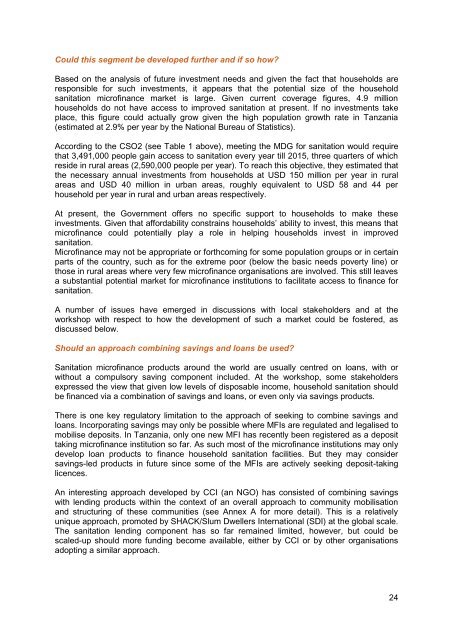REPORT__Evaluating_the_potential_of_microfinance_for_sanitation_in_Tanzania_May_2013
REPORT__Evaluating_the_potential_of_microfinance_for_sanitation_in_Tanzania_May_2013
REPORT__Evaluating_the_potential_of_microfinance_for_sanitation_in_Tanzania_May_2013
Create successful ePaper yourself
Turn your PDF publications into a flip-book with our unique Google optimized e-Paper software.
Could this segment be developed fur<strong>the</strong>r and if so how?<br />
Based on <strong>the</strong> analysis <strong>of</strong> future <strong>in</strong>vestment needs and given <strong>the</strong> fact that households are<br />
responsible <strong>for</strong> such <strong>in</strong>vestments, it appears that <strong>the</strong> <strong>potential</strong> size <strong>of</strong> <strong>the</strong> household<br />
<strong>sanitation</strong> micr<strong>of</strong><strong>in</strong>ance market is large. Given current coverage figures, 4.9 million<br />
households do not have access to improved <strong>sanitation</strong> at present. If no <strong>in</strong>vestments take<br />
place, this figure could actually grow given <strong>the</strong> high population growth rate <strong>in</strong> <strong>Tanzania</strong><br />
(estimated at 2.9% per year by <strong>the</strong> National Bureau <strong>of</strong> Statistics).<br />
Accord<strong>in</strong>g to <strong>the</strong> CSO2 (see Table 1 above), meet<strong>in</strong>g <strong>the</strong> MDG <strong>for</strong> <strong>sanitation</strong> would require<br />
that 3,491,000 people ga<strong>in</strong> access to <strong>sanitation</strong> every year till 2015, three quarters <strong>of</strong> which<br />
reside <strong>in</strong> rural areas (2,590,000 people per year). To reach this objective, <strong>the</strong>y estimated that<br />
<strong>the</strong> necessary annual <strong>in</strong>vestments from households at USD 150 million per year <strong>in</strong> rural<br />
areas and USD 40 million <strong>in</strong> urban areas, roughly equivalent to USD 58 and 44 per<br />
household per year <strong>in</strong> rural and urban areas respectively.<br />
At present, <strong>the</strong> Government <strong>of</strong>fers no specific support to households to make <strong>the</strong>se<br />
<strong>in</strong>vestments. Given that af<strong>for</strong>dability constra<strong>in</strong>s households’ ability to <strong>in</strong>vest, this means that<br />
micr<strong>of</strong><strong>in</strong>ance could <strong>potential</strong>ly play a role <strong>in</strong> help<strong>in</strong>g households <strong>in</strong>vest <strong>in</strong> improved<br />
<strong>sanitation</strong>.<br />
Micr<strong>of</strong><strong>in</strong>ance may not be appropriate or <strong>for</strong>thcom<strong>in</strong>g <strong>for</strong> some population groups or <strong>in</strong> certa<strong>in</strong><br />
parts <strong>of</strong> <strong>the</strong> country, such as <strong>for</strong> <strong>the</strong> extreme poor (below <strong>the</strong> basic needs poverty l<strong>in</strong>e) or<br />
those <strong>in</strong> rural areas where very few micr<strong>of</strong><strong>in</strong>ance organisations are <strong>in</strong>volved. This still leaves<br />
a substantial <strong>potential</strong> market <strong>for</strong> micr<strong>of</strong><strong>in</strong>ance <strong>in</strong>stitutions to facilitate access to f<strong>in</strong>ance <strong>for</strong><br />
<strong>sanitation</strong>.<br />
A number <strong>of</strong> issues have emerged <strong>in</strong> discussions with local stakeholders and at <strong>the</strong><br />
workshop with respect to how <strong>the</strong> development <strong>of</strong> such a market could be fostered, as<br />
discussed below.<br />
Should an approach comb<strong>in</strong><strong>in</strong>g sav<strong>in</strong>gs and loans be used?<br />
Sanitation micr<strong>of</strong><strong>in</strong>ance products around <strong>the</strong> world are usually centred on loans, with or<br />
without a compulsory sav<strong>in</strong>g component <strong>in</strong>cluded. At <strong>the</strong> workshop, some stakeholders<br />
expressed <strong>the</strong> view that given low levels <strong>of</strong> disposable <strong>in</strong>come, household <strong>sanitation</strong> should<br />
be f<strong>in</strong>anced via a comb<strong>in</strong>ation <strong>of</strong> sav<strong>in</strong>gs and loans, or even only via sav<strong>in</strong>gs products.<br />
There is one key regulatory limitation to <strong>the</strong> approach <strong>of</strong> seek<strong>in</strong>g to comb<strong>in</strong>e sav<strong>in</strong>gs and<br />
loans. Incorporat<strong>in</strong>g sav<strong>in</strong>gs may only be possible where MFIs are regulated and legalised to<br />
mobilise deposits. In <strong>Tanzania</strong>, only one new MFI has recently been registered as a deposit<br />
tak<strong>in</strong>g micr<strong>of</strong><strong>in</strong>ance <strong>in</strong>stitution so far. As such most <strong>of</strong> <strong>the</strong> micr<strong>of</strong><strong>in</strong>ance <strong>in</strong>stitutions may only<br />
develop loan products to f<strong>in</strong>ance household <strong>sanitation</strong> facilities. But <strong>the</strong>y may consider<br />
sav<strong>in</strong>gs-led products <strong>in</strong> future s<strong>in</strong>ce some <strong>of</strong> <strong>the</strong> MFIs are actively seek<strong>in</strong>g deposit-tak<strong>in</strong>g<br />
licences.<br />
An <strong>in</strong>terest<strong>in</strong>g approach developed by CCI (an NGO) has consisted <strong>of</strong> comb<strong>in</strong><strong>in</strong>g sav<strong>in</strong>gs<br />
with lend<strong>in</strong>g products with<strong>in</strong> <strong>the</strong> context <strong>of</strong> an overall approach to community mobilisation<br />
and structur<strong>in</strong>g <strong>of</strong> <strong>the</strong>se communities (see Annex A <strong>for</strong> more detail). This is a relatively<br />
unique approach, promoted by SHACK/Slum Dwellers International (SDI) at <strong>the</strong> global scale.<br />
The <strong>sanitation</strong> lend<strong>in</strong>g component has so far rema<strong>in</strong>ed limited, however, but could be<br />
scaled-up should more fund<strong>in</strong>g become available, ei<strong>the</strong>r by CCI or by o<strong>the</strong>r organisations<br />
adopt<strong>in</strong>g a similar approach.<br />
24


